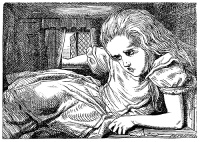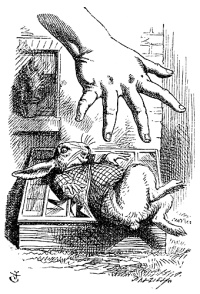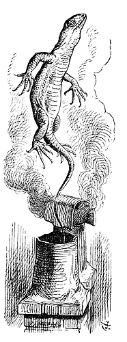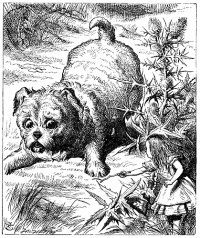The Rabbit Sends in a Little Bill
Studies in Alice IV, by Marc Edmund JonesThis lesson considers the fourth chapter of Alice in Wonderland and the fourth great principle of wisdom in the Philosophy of Concepts as revealed through the adventures of Alice is that man does not change. "Can the Ethiopian change his skin or the leopard his spots? then may ye also do good, that are accustomed to do evil." (Jeremiah 13:23) While this teaching is an integral part of the Ancient Mysteries and is found in the most archaic sources, its restatement in the modern world has been met with surprise and almost resentment although the principle has been considered by many the important and outstanding detail of the Philosophy of Concepts. Nevertheless it is curious to note the ingrained understanding of this changelessness of the real or inner man as demonstrated by any soul trained under the Mysteries in past ages. Thus the archaic teachings and the arcane wisdom of all ancient peoples have become the very cornerstone of modern occultism and in all religious leadership there is tendency to cling to the old with grim tenacity. Here is the blind influence of the few or the older souls. Growth in life is not change but because of the failure of humanity at large or the younger souls to realize this there is to be seen on all hands and in every age a constant chasing of will-o'-the-wisps and a frantic pursuit after nostrums claiming to change man into this, that or the other desirable state of being. Indeed, most of the real disillusionment in life is due to convincing some earnest individual that he can be changed and then when he wakes up some morning and discovers himself to be the same old self the whole foundation of his hope dissolves into nothingness. Growth is expansion or realization in self. Real self is changeless. Existence revolves in an orbit of which the simple sense of reality is the major focus. Only those things that are definitely built into the real inner self are eternal. All other items of relation to the outer world are destroyed with the passing into oblivion of outer and ephemeral being.
 Here is the principle of be
yourself that rapidly is becoming
the basis of the code of this new
day's civilization. More and
more men are coming to see that
conformity to external idea or
structure not only is subterfuge
but is hypocrisy destructive to
real self. Success and genuine
recognition of place in life are
seldom yielded to anyone on the
basis of copying prior
achievement but are granted
freely to that which is individual
or an expression of its true self.
The symbolism of this fourth chapter in Alice is therefore interesting in showing that no matter
what happens to Alice she is the same in real power and being, or that whether large or small she
is the same to herself and to those about her.
Here is the principle of be
yourself that rapidly is becoming
the basis of the code of this new
day's civilization. More and
more men are coming to see that
conformity to external idea or
structure not only is subterfuge
but is hypocrisy destructive to
real self. Success and genuine
recognition of place in life are
seldom yielded to anyone on the
basis of copying prior
achievement but are granted
freely to that which is individual
or an expression of its true self.
The symbolism of this fourth chapter in Alice is therefore interesting in showing that no matter
what happens to Alice she is the same in real power and being, or that whether large or small she
is the same to herself and to those about her. 
When she is penned up in the room of the rabbit's house she is aware of the discomfort of her size and she is perfectly willing to try to catch a little animal with her hand or kick at one of them in the chimney, but it never enters her head to associate unusual strength with unusual size or to attempt to break her way out of the house. Here the symbolical or fairy or apocalyptic narrative differs from the nonsymbolical satire or of a Swift. Gulliver remains permanently larger than the Lilliputians and the author uses every advantage of this difference in the invention of his detail. Alice to herself is proportionate to the room that to her is real, and she is unable to take advantage of her strength because her great size is proportionately unreal. The same point is illustrated later and with reverse emphasis when again as a tiny mite she plays with the puppy who towers over her and threatens her with its sheer weight and friendliness. Here is a parallel to the case of the elephant and the mouse. Size and other external accidents have nothing at all to do with reality.
 The achievement of imagination in the chapter, or the fourth great
scientific anticipation, is the revelation of the principles now known to
man through the science of the subconscious or psychoanalysis. The
expression of man is always seen as the product of his environment.
Thus Spinoza, the philosopher who largely paved the way for liberty in
the modern world, was molded to his work by his excommunication
from the synagogue at Amsterdam. Similarly Schopenhauer can be
seen in his pessimism to be the product of Europe's post-Napoleonic
headache and Nietzsche in his philosophy of abandon to be the product
of the sudden supremacy of higher criticism. Even Lewis Carroll
himself was the product of his own eccentricities of environment or his
lack of emotional outlet. Psychoanalysis as a further step is
discovering that outer environment itself is the result of the inner being
of man in its appearance or reality to man and this building by cosmic
affinity of the outer reality to fit the inner realization is curiously
indicated in the chapter by the reversal in the effects of the eucharistic
elements or the bottle that causes her to grow larger and the cakes that
make her grow smaller.
The achievement of imagination in the chapter, or the fourth great
scientific anticipation, is the revelation of the principles now known to
man through the science of the subconscious or psychoanalysis. The
expression of man is always seen as the product of his environment.
Thus Spinoza, the philosopher who largely paved the way for liberty in
the modern world, was molded to his work by his excommunication
from the synagogue at Amsterdam. Similarly Schopenhauer can be
seen in his pessimism to be the product of Europe's post-Napoleonic
headache and Nietzsche in his philosophy of abandon to be the product
of the sudden supremacy of higher criticism. Even Lewis Carroll
himself was the product of his own eccentricities of environment or his
lack of emotional outlet. Psychoanalysis as a further step is
discovering that outer environment itself is the result of the inner being
of man in its appearance or reality to man and this building by cosmic
affinity of the outer reality to fit the inner realization is curiously
indicated in the chapter by the reversal in the effects of the eucharistic
elements or the bottle that causes her to grow larger and the cakes that
make her grow smaller.
This is the all-important law of cosmic reversal whereby the subconscious realm is the inverse reflection of the conscious one, so that frequently in dreams as interpreted by psychoanalysis the symbols are seen to operate by exact contraries. As vegetable and animal life complement each other in the interchange of oxygen and carbon dioxide as a point of importance in the following lesson so the conscious and subconscious realms mutually give life to each other. Now that Alice at last has become orientated to the subconscious realm, aptly shown here as underground, the hall with its little door or the whole apparent aspect of her outer environment is transformed.
 The law of applied psychology or the fourth
big idea for the solution of personal problems
is brought out here in the technique of
adaptability. When a strong man in
vaudeville was asked how he had learned to
lift a cow he replied that he had begun when
she was a calf, and adaptability is similarly
but seriously gained by a beginning to adapt
the most trivial and seemingly far from useful
things to personal needs. Everything in life is
grist to the mill according to the proverb
quoted by John Ray in 1670 and man is even
aided by the missiles cast at him. Samuel
Johnson remarked in 1784, "Sir, if they
should cease to talk of me I must starve."
Alice began to conquer her predicament when
she began to use what was immediately at
hand, particularly the pebbles thrown in at
her. Here is illustrated the phenomenon of
foods and poisons. Love apples have become
tomatoes and gained edibility with the change
of name. Many other poisonous and semi-poisonous growths have been adapted by man and
become nonpoisonous simply because the use of any material adapts to its use. Alice's arm was
out the window and everyone subconsciously reaches out into the unknown. Alice's foot was in
the fireplace and so man rests always on the ashes of present self. The student must learn to
PUT MISFORTUNE TO WORK, to eat the pebbles that life casts at him to try him. If he is in a
predicament he must clutch , kick at something, or else cry out and affirm himself in some
definite fashion. This brings response from life and if the response is pebbles his affirmative
consciousness will transform these into the magic cakes he needs.
The law of applied psychology or the fourth
big idea for the solution of personal problems
is brought out here in the technique of
adaptability. When a strong man in
vaudeville was asked how he had learned to
lift a cow he replied that he had begun when
she was a calf, and adaptability is similarly
but seriously gained by a beginning to adapt
the most trivial and seemingly far from useful
things to personal needs. Everything in life is
grist to the mill according to the proverb
quoted by John Ray in 1670 and man is even
aided by the missiles cast at him. Samuel
Johnson remarked in 1784, "Sir, if they
should cease to talk of me I must starve."
Alice began to conquer her predicament when
she began to use what was immediately at
hand, particularly the pebbles thrown in at
her. Here is illustrated the phenomenon of
foods and poisons. Love apples have become
tomatoes and gained edibility with the change
of name. Many other poisonous and semi-poisonous growths have been adapted by man and
become nonpoisonous simply because the use of any material adapts to its use. Alice's arm was
out the window and everyone subconsciously reaches out into the unknown. Alice's foot was in
the fireplace and so man rests always on the ashes of present self. The student must learn to
PUT MISFORTUNE TO WORK, to eat the pebbles that life casts at him to try him. If he is in a
predicament he must clutch , kick at something, or else cry out and affirm himself in some
definite fashion. This brings response from life and if the response is pebbles his affirmative
consciousness will transform these into the magic cakes he needs.

Sabian.org





